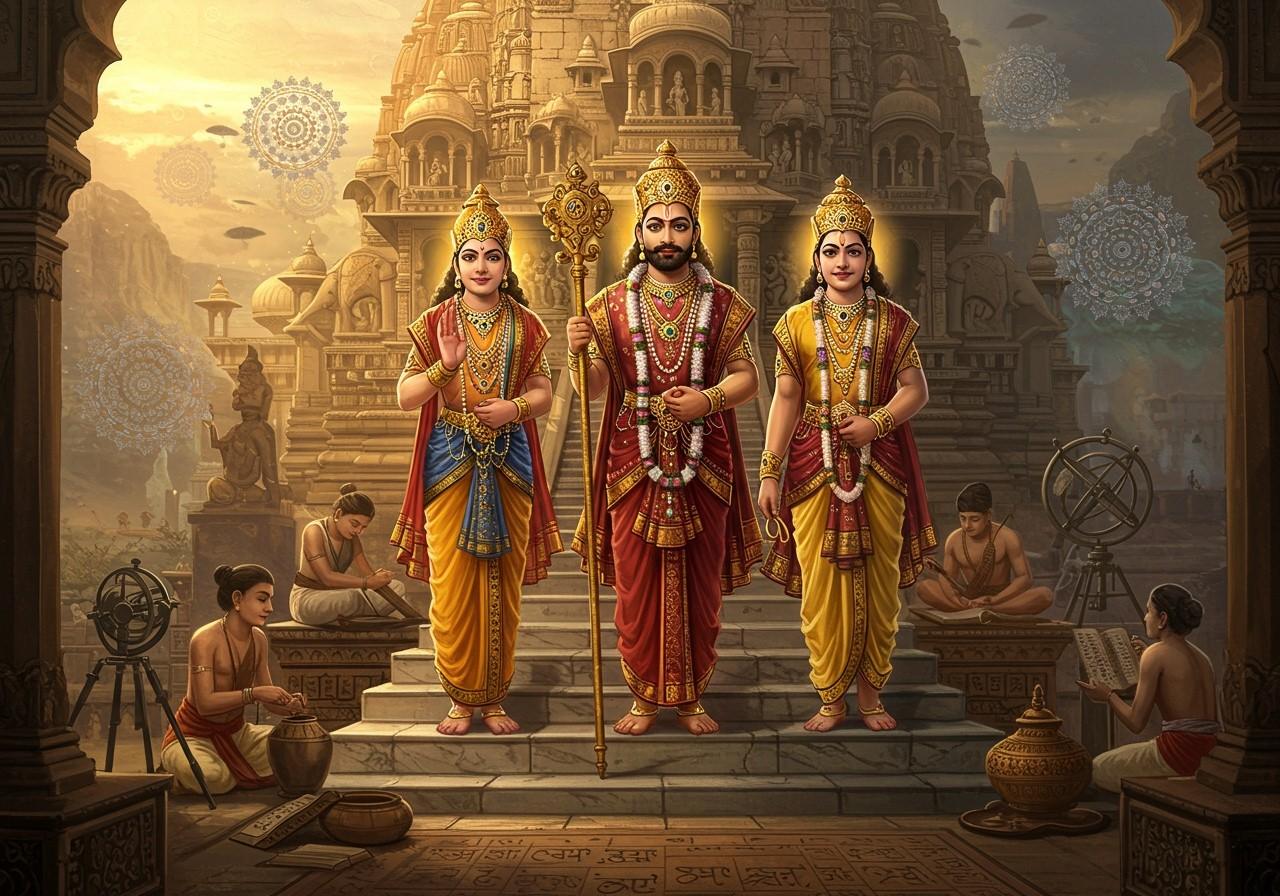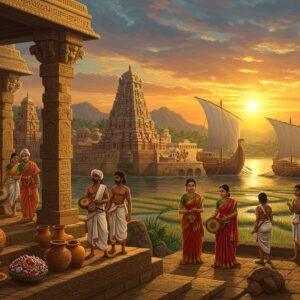
The Varman Dynasty (350-650 AD) holds a significant place in the history of Assam and India. This dynasty shaped the socio-political, cultural, and religious landscape of northeastern India, leaving behind a rich legacy. From its origins in the ancient Kamarupa kingdom to its notable rulers and achievements, the Varman Dynasty represents a pivotal period in the region’s development.
Origins and Rise to Prominence
The Varman Dynasty emerged from the ancient Kamarupa kingdom, present-day Assam. Pushyavarman, a contemporary of Samudragupta, founded the dynasty around 350 AD. Initially, the Varmans were subordinate to the powerful Gupta Empire. However, as the Gupta influence waned, the Varmans seized the opportunity to assert their independence and establish their own powerful kingdom. This marked the beginning of a prosperous era for the region.
Key Figures of the Varman Dynasty
Several rulers contributed to the Varman Dynasty’s prominence. Understanding their individual reigns provides a deeper appreciation for the dynasty’s overall impact:
- Pushyavarman (c. 350-374 AD): The founder of the dynasty, Pushyavarman laid the groundwork for future rulers. His reign marked the beginning of a new era in Kamarupa, transitioning from Gupta subordination to independent rule. He established a strong foundation for future expansion and prosperity.
- Samudravarman (c. 374-398 AD): Known for his military and administrative prowess, Samudravarman consolidated the kingdom’s power and stability. His leadership strengthened the dynasty’s position and paved the way for future territorial expansions.
- Mahendravarman (c. 470-494 AD): Mahendravarman played a crucial role in expanding the kingdom’s boundaries and consolidating power. His reign signifies a period of significant growth and influence for the Varman Dynasty.
- Bhaskaravarman (c. 594-650 AD): Considered the last and most notable ruler of the Varman Dynasty, Bhaskaravarman established diplomatic relations with the Chinese Tang Dynasty. His reign is renowned for its cultural achievements and international recognition, fostering trade and cultural exchange.
- Narayanavarman (c. 650-685 AD) and Kalyanavarman: While less prominent than Bhaskaravarman, these rulers also played roles in the dynasty’s history. Their contributions to governance and administration helped maintain stability during a transitional period.
Achievements and Contributions
The Varman Dynasty’s legacy is built upon a range of significant achievements:
- Military Conquests: The Varman rulers were skilled military strategists who expanded their kingdom through successful campaigns. Their military prowess ensured the kingdom’s security and contributed to its growing influence in the region.
- Administrative Reforms: The Varmans implemented effective governance practices, improving the administration’s efficiency and the kingdom’s overall management. These reforms strengthened the dynasty’s control and facilitated its expansion.
- Cultural Flourishing: The Varman Dynasty fostered a vibrant cultural atmosphere, marked by the construction of temples, patronage of the arts, and the flourishing of literature. This support enriched the region’s cultural heritage and left a lasting impact on Assamese culture.
- Trade and Economic Growth: The rulers actively promoted trade within their kingdom and with neighboring regions. This focus on commerce boosted economic prosperity and strengthened the kingdom’s overall stability.
- International Diplomacy: Bhaskaravarman’s diplomatic ties with the Chinese Tang Dynasty showcased the dynasty’s international influence. These relationships facilitated cultural exchange and contributed to a period of relative peace and stability.
Religious and Cultural Influence
The Varman Dynasty profoundly influenced the religious and cultural landscape of Assam:
- Patronage of Hinduism: The rulers promoted Hinduism, particularly Shaivism and Vaishnavism, strengthening these religious traditions within the kingdom. This royal support helped solidify Hinduism’s place as a dominant religion in the region.
- Temple Architecture: The construction of magnificent temples and religious monuments stands as a testament to the dynasty’s architectural prowess and religious devotion. These structures became important centers of worship and cultural landmarks.
- Assamese Literature and Arts: Under the patronage of the Varman rulers, classical Assamese culture and literature flourished. Scholars, artists, and poets received royal support, enriching the region’s cultural fabric.
Decline and End of an Era
The decline of the Varman Dynasty was brought about by a combination of factors:
- Internal Conflicts: Succession disputes and internal power struggles weakened the dynasty’s stability. These conflicts diverted resources and attention away from external threats and administrative matters.
- External Pressures: Invasions from neighboring kingdoms further destabilized the Varman rule. These external pressures strained the kingdom’s resources and weakened its defenses.
- Rise of Rival Dynasties: The emergence of rival dynasties, such as the Mlechchha dynasty, challenged the Varman’s authority and contributed to their eventual downfall. The rise of new powers marked a shift in the regional political landscape.
Poojn.in: Your Source for Cultural and Religious Items
At Poojn.in, we understand the importance of honoring and celebrating India’s rich cultural and religious heritage. As India’s leading online store for cultural and religious goods, we offer a wide selection of products to support your devotional practices. Explore our collection of high-quality puja items, idols, and accessories, carefully sourced and crafted to enhance your spiritual journey. Visit www.poojn.in today and discover everything you need for your puja needs.
For devotees interested in learning more about the Varman Dynasty and other aspects of Indian history and culture, Poojn.in also offers a curated selection of books and educational resources. Deepen your understanding of India’s rich heritage with our carefully chosen collection. Visit www.poojn.in to explore our educational resources.
Legacy and Remembrance
Despite its decline, the Varman Dynasty left an indelible mark on Assam’s history and culture. The monuments, temples, and literary works from this period serve as lasting reminders of the dynasty’s golden era. Archaeological discoveries continue to shed light on this significant period, contributing to a deeper understanding of the Varman Dynasty’s impact on Indian history.
Ramayana Characters and Life Lessons
Dharma in the Ramayana: A Thematic Exploration
Ramayana Timeless Lessons for Modern Life
Ramayana Women: Their Strength and Modern Relevance
Ramayana Bridge: Significance, Myth, or Reality Explained
Ramayana’s Enduring Influence on Indian Culture
Kandariya Mahadeva Temple: Religious Importance and History
Khajuraho and Kandariya Mahadeva: A Cultural Heritage Journey
Chandela Dynasty Architecture: The Kandariya Mahadeva Temple Legacy
Sas-Bahu Temples: A Guide to Their Architectural Wonders
India’s Sas-Bahu Temples: A Complete Guide to Locations, History, and Significance


